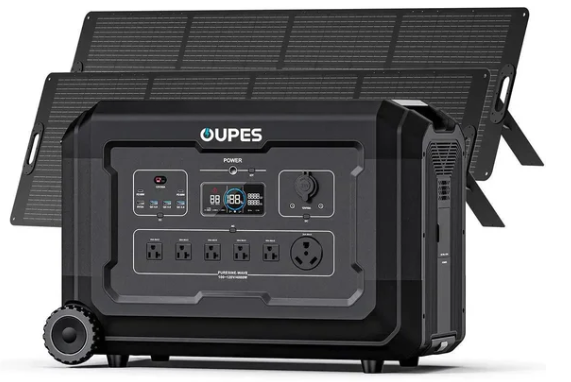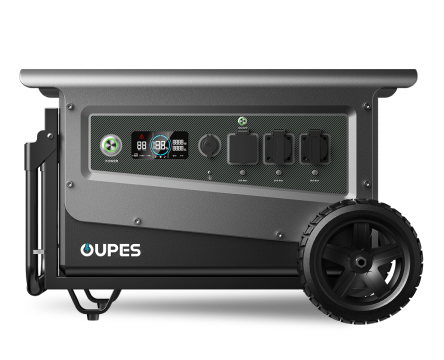
Table of Contents
- Introduction
- How Solar Backup Systems Work
- Core Components of a Solar Backup System
- Can Solar Systems Truly Power an Entire Home?
- How to Size a Solar Backup System
- Comparison: Whole-Home Backup vs. Portable Power Stations
- Factors Influencing System Performance
- Using Portable Power Stations with Solar Systems
- FAQ
Introduction
Solar energy has transformed how modern homes maintain power reliability. A solar backup system not only reduces dependence on the electrical grid but also provides essential power during outages. But can such a system truly run an entire home — including large appliances and heating systems — without interruption?
According to the U.S. Department of Energy, a well-designed solar-plus-storage system can power key household loads for 24 hours or more, depending on capacity and sunlight conditions. This article explores how solar backup systems work, their technical limitations, and how they complement portable power stations such as those from OUPES for hybrid energy reliability.
How Solar Backup Systems Work
1. Energy Generation and Conversion
Solar panels absorb sunlight and convert it into direct current (DC). The inverter then converts DC into alternating current (AC) — the type used by most home appliances. Excess energy not immediately consumed is stored in batteries for use during the night or grid outages.
2. Automatic Transition During Outages
When a blackout occurs, an Automatic Transfer Switch (ATS) isolates the home from the grid and seamlessly switches to battery power. This process happens in less than a second, keeping lights, Wi-Fi, and essential devices powered without interruption.
3. Energy Management and Smart Control
Modern systems use smart energy management software to prioritize critical loads and optimize charging from solar panels. This ensures longer battery life and consistent operation even under limited sunlight.
Core Components of a Solar Backup System
1. Solar Panels
These are the primary energy source, typically made of monocrystalline or polycrystalline silicon. An average U.S. home requires between 15–25 panels (rated 350–450W each) to generate enough energy for full backup.
2. Battery Bank
Batteries store solar energy for nighttime or emergency use. Modern systems use LiFePO4 (Lithium Iron Phosphate) technology due to its stability, safety, and long lifespan — often exceeding 3,000 charge cycles. Portable power stations from brands like OUPES utilize the same chemistry for safe, efficient backup storage on a smaller scale.
3. Inverter and Charge Controller
The inverter converts DC power to AC, while the charge controller regulates voltage and prevents overcharging. These ensure safe operation, efficient conversion, and reliable output for home circuits.
4. Smart Load Panel
This component prioritizes power delivery to essential devices (refrigerator, lighting, internet router, etc.), ensuring critical systems stay operational when battery capacity is limited.
Can Solar Systems Truly Power an Entire Home?
1. The Reality of Whole-Home Backup
Yes, but it depends on system size and energy consumption. A full-house solar backup requires sufficient battery capacity and inverter power to handle peak loads like HVAC units, water heaters, and electric stoves.
2. Average Household Energy Demand
The average U.S. household consumes around 30 kWh of electricity per day. To support this demand, you typically need:
- Solar array: 7–10 kW
- Battery storage: 20–30 kWh
- Inverter capacity: 5–10 kW continuous output
3. Practical Scenarios
A single battery system may power essential loads for 12–24 hours. To achieve true whole-home coverage — including HVAC or electric vehicle charging — multiple batteries or modular systems must be linked together.
How to Size a Solar Backup System
1. Calculate Energy Usage
Review your utility bill for average daily consumption. If your home uses 900 kWh per month, that equals roughly 30 kWh per day.
2. Account for Solar Production
Assuming 5 hours of effective sunlight per day, a 6 kW solar system produces about 30 kWh daily — enough for most homes under moderate load conditions.
3. Determine Battery Needs
Battery storage should match at least one day of power consumption (30 kWh). For multi-day resilience, double or triple this capacity, depending on local weather and critical needs.
4. Plan for Peak Power
Your inverter must handle high-power devices starting simultaneously. For example, an air conditioner (3,000W) and refrigerator (800W) can exceed 4 kW combined — requiring an inverter rated above 5 kW for stable operation.
Comparison: Whole-Home Solar Backup vs. Portable Power Station
| Feature | Whole-Home Solar Backup | Portable Power Station (Solar Generator) |
|---|---|---|
| Energy Capacity | 10–50 kWh (expandable) | 0.5–5 kWh typical |
| Installation | Permanently installed, professional setup | Plug-and-play, no installation needed |
| Mobility | Stationary, fixed to home circuits | Portable, ideal for outdoor or RV use |
| Cost | High initial cost, long-term savings | Affordable, flexible short-term backup |
| Use Case | Whole-house backup and grid independence | Emergency power for essential devices |
While whole-home systems provide long-term stability, portable solar generators offer flexibility and mobility. During outages, a homeowner could use a whole-home system to power critical circuits while a portable unit, such as one from OUPES, supports mobile electronics or outdoor lighting.
Factors Influencing System Performance
1. Sunlight Availability
Solar efficiency depends on regional sunlight exposure. Areas with 4–6 hours of full sun daily (like California or Texas) provide optimal conditions for full-home power.
2. Battery Capacity and Depth of Discharge (DoD)
LiFePO4 batteries with 90% DoD offer longer usable energy compared to lead-acid systems, extending backup runtime and lifespan.
3. Energy Efficiency at Home
Reducing power consumption — by using LED lighting and ENERGY STAR appliances — allows smaller systems to sustain more devices during outages.
4. Weather and Seasonal Factors
Cloudy or snowy weather reduces solar panel output. Combining solar systems with stored battery energy ensures reliability year-round.
Using Portable Power Stations with Solar Systems
1. Hybrid Backup Setup
Portable solar generators can complement whole-home systems by serving as secondary storage. They’re especially useful for powering specific rooms, tools, or RVs during extended outages.
2. Flexibility and Portability
Devices like OUPES portable power stations can be charged via rooftop panels or standalone solar kits. This flexibility makes them valuable not just for emergencies but also for off-grid adventures or mobile workstations.
3. Cost Efficiency
Instead of expanding a large battery bank, combining a main solar system with one or two portable stations provides scalable, affordable backup capacity.
FAQ
1. Can a solar backup system power my entire home continuously?
Yes, if the system is large enough to meet your home’s daily energy demand and includes adequate battery storage.
2. How long can a solar backup system run during an outage?
A typical 30 kWh battery can power essential loads for 24–48 hours. Adding solar panels allows recharging during the day for extended autonomy.
3. What happens during cloudy or rainy days?
Energy generation decreases, but stored battery power can still supply electricity. Portable units can supplement capacity for smaller appliances.
4. Do I need both a solar system and a portable power station?
For maximum flexibility, yes. A whole-home solar system provides long-term backup, while a portable solar generator offers mobility and quick access to power.
5. Are solar backup systems worth the investment?
According to the National Renewable Energy Laboratory, homes with solar storage can save up to 60% on annual electricity costs while increasing energy independence.
6. Are these systems safe?
Modern systems use advanced BMS protection and LiFePO4 chemistry, ensuring safe, stable operation even under heavy load.




























